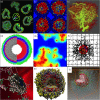Hybrid modeling frameworks of tumor development and treatment
- PMID: 31313504
- PMCID: PMC6898741
- DOI: 10.1002/wsbm.1461
Hybrid modeling frameworks of tumor development and treatment
Abstract
Tumors are complex multicellular heterogeneous systems comprised of components that interact with and modify one another. Tumor development depends on multiple factors: intrinsic, such as genetic mutations, altered signaling pathways, or variable receptor expression; and extrinsic, such as differences in nutrient supply, crosstalk with stromal or immune cells, or variable composition of the surrounding extracellular matrix. Tumors are also characterized by high cellular heterogeneity and dynamically changing tumor microenvironments. The complexity increases when this multiscale, multicomponent system is perturbed by anticancer treatments. Modeling such complex systems and predicting how tumors will respond to therapies require mathematical models that can handle various types of information and combine diverse theoretical methods on multiple temporal and spatial scales, that is, hybrid models. In this update, we discuss the progress that has been achieved during the last 10 years in the area of the hybrid modeling of tumors. The classical definition of hybrid models refers to the coupling of discrete descriptions of cells with continuous descriptions of microenvironmental factors. To reflect on the direction that the modeling field has taken, we propose extending the definition of hybrid models to include of coupling two or more different mathematical frameworks. Thus, in addition to discussing recent advances in discrete/continuous modeling, we also discuss how these two mathematical descriptions can be coupled with theoretical frameworks of optimal control, optimization, fluid dynamics, game theory, and machine learning. All these methods will be illustrated with applications to tumor development and various anticancer treatments. This article is characterized under: Analytical and Computational Methods > Computational Methods Translational, Genomic, and Systems Medicine > Therapeutic Methods Models of Systems Properties and Processes > Organ, Tissue, and Physiological Models.
Keywords: mathematical modeling; mathematical oncology.
© 2019 The Authors. WIREs Systems Biology and Medicine published by Wiley Periodicals, Inc.
Conflict of interest statement
The authors have declared no conflicts of interest for this article.
Figures




References
FURTHER READING
-
- Altrock, P. M. , Liu, L. L. , & Michor, F. (2015). The mathematics of cancer: Integrating quantitative models. Nature Reviews Cancer, 15, 730–745. - PubMed
References
-
- Audet, C. , & Dennis, J. E. (2006). Mesh adaptive direct search algorithms for constrained optimization. SIAM Journal on Optimization, 17(1), 188–217.
-
- Audet, C. , Kokkolaras, M. , Digabel, S. L. , & Talgorn, B. (2018). Order‐based error for managing ensembles of surrogates in mesh adaptive direct search. Journal of Global Optimization, 70(3), 645–675.
Publication types
MeSH terms
Grants and funding
LinkOut - more resources
Full Text Sources
Other Literature Sources
Medical

